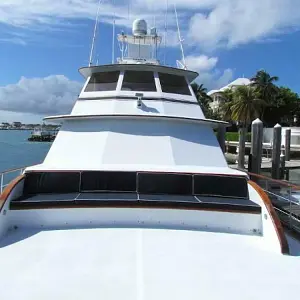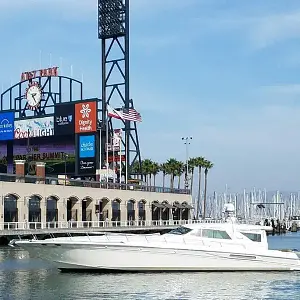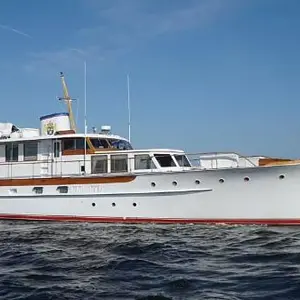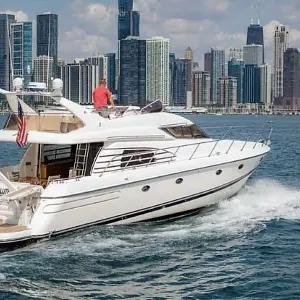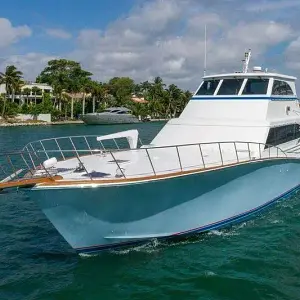66ft. COMMUTER MOTOR-YACHT – 1927 – Tams & King, New York – Cruising Liveaboard – Lying: River Medway
HISTORY & DESCRIPTION:
Designed by Tams and King Incorporated of 250 Park Avenue, New York City, USA, for the 1927 season. From as early as 1869 an early craze for fast gentlemen’s yachts emerged on Lake Windermere. Not to be outdone, the craze moved across the Atlantic to the shores of the East Coast of America where numerous famous personalities acquired equally and perhaps more luxurious steam yachts. Between the Wars, a need by the many wealthy men of fortune from Wall Street to spend their wealth on craft gave the creation of nearly three hundred vessels, ranging from 25ft to 300ft. Speed was essential and the game was to race from their homes to the landing stage at the foot of 23rd Street on the Hudson River and the exclusive use of the pier at 26th Street on the East River in New York. The boats soon became faster and faster as each new construction became a reality, its duty to get its owner to work and home the fastest. They soon took on nicknames as Fast Commuters or Flyers. The accommodation was generally minimal but plush, speed being the utmost need of its owner. Altogether over 300 Commuters were built, constructed from numerous yards along the Eastern Seaboard. One of the owners was Mr Patrick Grant 2nd, of Philadelphia, who had the above designers and builders, construct the 66ft long, 45mph Commuter called PHANTOM. She was constructed to a V-bottom design. The two engines were arranged in echelon, the starboard engine being forward of the port one. This enabled ample space in the engine-room. The engine trunk was low and originally a short cabin aft was built incorporating a pantry and toilet. A notable feature of this craft was a huge cockpit forward, above which was fitted a helm’s position. This gave him a clear vision at all times, perhaps something of a must when travelling then at 38.5 mph. The hull is longitudinal in design, Honduras Mahogany lined internally with Cedar on Oak frames. After the death of Mr Grant, PHANTOM was sold by Tams & King to Ralph Pulitzer of New York City.
10.01.28 Mr Pulitzer was not happy with the design of the craft and decided that her builders should carry out alterations that enabled the craft to operate for more than just on day runs. To enable her to perform these tasks of cruising Mr Pulitzer had the forward cockpit divided by athwartships bulkhead. Up front a windscreen was constructed and a wide cushioned seat fitted across the width of the boat. The original deck shelter was removed aft and the after cabin was given up to the galley which was fitted with a Propane stove, large icebox, dresser, sink and numerous other fashionable fittings. A hatch was constructed with a suction scoop over the galley. The main cabin was lengthened to enable the construction of a sofa berth on the port side and a cushioned seat opposite. Forward amidships of this cabin a drop leaf table was moulded in. The berth on the starboard side was removed to allow the construction of lockers externally to be built. The original toilet aft remained but the pantry was converted into a dressing room and wardrobe. Due to the success of this modified design several similar craft were being contemplated by the builders and designers. Her twin Wright Typhoon engines turning Hyde propellers enabled the PHANTOM to maintain cruising speeds of 36 mph.
23.09.30 An article about PHANTOM appeared in the Newspaper Niagara Falls NY Gazette by Richard Masson. The craft is listed in Lloyds Register of Yachts of the United States and Canada with an Official Number of 226498. Apparently now owned by a Mr Harrison Williams who had called the craft WHIM. Previously to that name the craft had been called VAMPIRE as recorded in the Lloyds list of Yachts.
In 1940 the British soon realised they needed more suitable craft to support their efforts to the RAF in recovering airmen from the sea. Already those craft suitable for such missions had been earmarked by the Ministry of War Transport and were quickly requisitioned after Operation Dynamo. To supplement these requisitioned vessels the MOWT looked overseas for such craft. At this time the USA was not entering the conflict and as such it soon became evident there was an abundance of craft suitable for such tasks over the pond. At this time President Franklin D Roosevelt had committed the United States in June 1940 to materially aiding the opponents of fascism, but, under existing United States law, Great Britain had to pay for its growing arms purchases from the United States with cash. Known then as “cash-and-carry”. By the summer of 1940, the new British Prime Minister, Winston Churchill, could not continue paying for such material. By the end of 1940, Roosevelt proposed and obtained the US Congress approval for the Lend-Lease Act in March 1941. However, it now emerges the requirements to supply the British by the USA of air-sea rescue boats must have been agreed under the cash-and-carry terms.
During 1939-40, Ken Stein was the purchasing agent for the British Government. Boats bought were re-modelled, painted camouflage in his boatyard at Sayville. Once ready they were delivered by Captain Stein and his son Ken to New York Harbour where they were loaded onto freighters bound for England. A lot of work was carried out by the Stein’s to the specification of the British Government. It is envisaged that once across the pond the boats were off-loaded and re-inspected by British Officials to ensure they were suitable for the allocated tasks they had been given.
WHIM was allocated from C&M for service at Portsmouth Naval Dockyard in the Special Service Pool, subject to survey. 07.04.45 Craft was inspected by Lt. Cdr. Sullivan.
11.04.45 In, (SVP2149/45), WHIM is reported no longer required for naval service, and DofC to make the necessary disposal arrangements. 07.09.46 Craft disposed of through DSCD, (CP10320/44) refers.
14.01.49 Deleted from MOV/NSC in BR 1315.
00.05.52 Lloyds Register of Yachts gives ownership to Mrs J.A. PEACOCK of no registered address, Port of Registry was Poole. Craft was still called WHIM Ex-Vampire, Ex-Phantom. No Official Number. Reported engines installed were twin Thornycroft Petrol Engines each 4Cy. 4.375″-5.5″ built in 1931. Phil Peacock and his wife Joyce bought the WHIM as a houseboat and raised his family on board until they became of age. During his time onboard he sold her original engines and refitted her with Foden Mk 1 two-stroke engines coupled to gearboxes from the company, Self Changing Gears Ltd.
Whilst at Cobb’s Quay her next owner became aware of the WHIM when one of the Peacock’s sons worked on the former naval pinnace BLANCHE, he then owned in 1984.
1988 Bought by the present owner from Mr Peacock whilst the craft was located at Cobbs Quay, Hamworthy, Poole. Joyce Peacock had become ill and needed to move ashore. After many months of particular attention by Mr Allen, 8000 silicon bronze screws supplied by Comwich Marine enabled the re-fastening of the planking and survival of this unique craft to continue. This work, although not essential was recommended by Cox & Co, navel architects, Cobb’s Quay.
Dave Allen whilst living in London, needed to bring the vessel to London in order to conduct ongoing maintenance. She was brought to Tough’s Boat Yard at Teddington via Brighton and Ramsgate around 1990. Mr Allen continued to manage the vessel while in ownership of a friend. 31.08.90 Vessel owned by Mr J Andrews for a 9 year period of time and then re-sold to Mr D Allen.
1992 Mr Allen replaced the Mk 1 Foden engines with Mk 2 version the former being obsolete. These were nearly the same apart from having six separate cylinder heads rather than two banks of three and spares for such were readily available from Rolls Royce. Whilst at Teddington Dave Allen skippered for Mr Andrews, occasionally travelling to the Thames Estuary and Ramsgate on fishing expeditions with friends.
1992 Due to Tough’s Boat Yard being sold off to property developers, a new mooring at Chiswick Marina.
1994 After a period of two years at Chiswick, NEW YORKER was moved to find new moorings at Hoo Marina on the Hoo Peninsular, Kent. Whilst there Mr Andrews and friends continued weekend trips to and around the Sheerness area.
01.07.96 Called NEW YORKER with Official No. 388739 and Port of Registry as Portsmouth. Described as a Pleasure Yacht with Foden engines producing 179.00 kW.
30.09.99 Registered owner D R Allen. 2001 After five years at Hoo Marina, Dave Allen moved the NEW YORKER to its present mooring at Port Medway Marina.
2003 It was decided that as the shafts etc needed updating due to wear/tear/age, being in good order, NEW YORKER pride could be re-established by installing higher output engines. The 120hp Mk 2 Fodens were replaced with 360hp Scania 12 litre straight-six diesel engines along with new RPM 1500SC, 1.58 x 1 gearboxes, turbo intercoolers, heat exchangers etc. These engines were salvaged from road accident lorries, in good order from Snows, Bristol. New turbos were fitted along with new starter motors supplied by Scania. The start-up of these new engines exhibit clean running as documented on the re-launch filming, (DVD) and survey. Most of the equipment, 2” stainless steel shafts, gearboxes, heat exchangers, turbo intercoolers were supplied by Lancing Marine of Portslade. Propellers’ by a company that has now retired, four-bladed aqua poise 22” x 25.5” which return a speed of 21 knots, GPS. New shaft logs were also installed.
Patrick Grant 11 (1st Owner)
Patrick Grant II was born in 1886 in Boston, Massachusetts. His parents were Robert Grant, Boston probate judge, and Amy Gordon Galt. He enrolled at Harvard University where he played on the Harvard Crimson football team. After the 1907 season, he was selected as a consensus first-team centre on the 1907 College Football All-America Team. He graduated from Harvard in 1908. In 1912, Grant ran an aviation school at Seabreeze, Florida. While in Florida, he became engaged to Marie S. Disston. The two were married in September 1912. They had a daughter in approximately 1916. Grant served with the Royal Canadian Flying Corps and won an amateur golf tournament in 1919. In the 1920s, Grant managed the statistical department at the banking firm of Townsend, Whelen & Co. in Philadelphia Pennsylvania. He died on the 28th October 1927 at age 39 when he fell from the window of his office on the fifth floor of an office building on Walnut Street in Philadelphia. It is reported that when he fell to his death, he still wore his overcoat, and his wallet and pockets contained $282. At the time of his death, he was announced as a wealthy banker and golfer.
Ralph Pulitzer (2nd Owner)
Ralph Pulitzer (June 11, 1879 – June 14, 1939) was the eldest son of newspaper magnate Joseph Pulitzer and Kate Davis Pulitzer. Upon his father’s death in October 1911, he became the president of the Press Publishing Company, which published the New York World and the Evening World newspapers. He thus acquired control of the influential New York City newspapers founded by his father. For decades, Ralph Pulitzer was one of the most influential men in American journalism. Born in Saint Louis, Missouri, Pulitzer was raised in great wealth. He was privately tutored until the age of 16, then attended St. Mark’s School of Southborough and Harvard University. He was married twice. In 1905 he married Frederica Vanderbilt Webb. They had two sons, Ralph Jr. and Seward Webb Pulitzer. They divorced in Paris, France in 1924. In 1928 he married Margaret Leech, who, after his death, received two Pulitzer Prizes for her own work. An active supporter of the National Air Races, Ralph Pulitzer sponsored the Pulitzer Trophy Race to encourage higher speed in land planes. Ralph Pulitzer is the author of “Over the Front in an Aeroplane and scenes inside the French and Flemish Trenches”, which he wrote after spending several days as the guest of the French War Office during World War I. According to his introduction, “No other civilian has been allowed to ascend in a French army aeroplane at all, and as for visiting the front in one, it has apparently been undreamed of.” His book contains wonderful descriptions of life in the trenches and the artillery used by the French in the early months of the War. It also includes sixteen photographs taken during his tour of several locations on the Front (presumably by the author or someone in his party). Pulitzer died a few days after his 60th birthday from complications following abdominal surgery on May 1. At the time of his death, he was a vice president of Pulitzer Publishing Company, which still published the St. Louis Post-Dispatch. He had retired as publisher of the New York World a year before the paper’s acquisition by E. W. Scripps Company, owner of The New York Telegram. The merged newspaper was renamed the World-Telegram. Pulitzer cited ill health as the reason for his retirement from the World. He was considered as part of the WHO’s WHO around the Bay in the 1920s that participated with The Great Gatsby Boat Tour of Long Island Sound.
CONSTRUCTION:
NEW YORKER is of double skin construction with outer planking of Honduras Mahogany and inner planking of cedar, silicon bronze fastened to oak timbers and frames. Bronze keel bolts. Cabin and wheelhouse structure of marine ply with mahogany coachroof, cascover sheathed. Decks of mahogany, plywood sheathed and finished with West epoxy resin. Vetus hatches. Steel pulpit and deck stanchions with timber cappings. Hard chine construction with full-length keel, transom stern and plumb straight stem.
Comfortable accommodation with hardwood joinery offering six berths in three cabins. Large saloon, galley, dinette, guest cabin, shower room, heads, master cabin with ensuite bathroom. Dedicated engine room and aft cockpit. 24 and 240-volt electrics throughout.
BROKERS NOTE:
A unique opportunity to acquire a rare and desirable 1920s New York Commuter with a long and fascinating history. An ideal cruising liveaboard or for extended holidays afloat/second home. Offered in full commission and available for inspection by appointment. Recommendation from a June 2015 survey completed. 2020 re-paint and refurbishment.
GUIDE PRICE: £246,000
LYING: River Medway
VIEWING: Through the agents – CLASSIC YACHT BROKERAGE –
Disclaimer
